第二节 儿童糖尿病
《儿童糖尿病》PPT课件

第2期—启动自身免疫反应。环境因素
1.病毒感染:柯萨奇B4病毒、腮腺炎病毒、风疹病毒、巨细胞病
毒、脑炎心肌炎病毒等。
2.人工喂养:由于新生儿胃肠道屏障功能还未完善,若出生后用
牛奶或牛奶的配方制剂喂养,有些儿童以后发生1型糖尿病的危险
性增加。研究表明,牛奶中有两种蛋白质即牛白蛋白和酪蛋白。
牛白蛋白与胰岛细胞中的一种成分ICA69有同源性。
第6期 在1型糖尿病发病后数年,多数患者胰岛B细胞完全
破坏,胰岛素水平极低,失去对刺激物的反应,糖尿病临床 表现明显。
精选课件
14
自然病程
1.急性期:起病较急。临床表现常是突然发病。如未能及时
诊断治疗可进展为酮症酸中毒危及生命。80%以上的病例在 发病一月内作出诊断,开始治疗。
2.缓解期:急性期得到正确的胰岛素及饮食治疗数周后,约
精选课件
9
糖尿病时代谢紊乱(二):
脂肪代谢紊乱
表现为血脂升高,进而出现酮血症及酮尿。这是由于: 1.合成减慢。脂肪细胞摄取葡萄糖减少, 脂肪组织中葡 萄糖代谢速度下降,脂肪酸合成减慢, 脂肪细胞内合成 甘油三酯的底物减少及脂肪酯化受抑制;2.分解增加。 因胰岛素缺乏,对脂肪分解的抑制作用减弱,血脂增加, 肝细胞中肉毒碱脂酰转移酶系统活力增加,脂肪酸进入 线粒体氧化增多,生成酮体的底物增多。
2/3的病例胰岛功能暂时恢复,进入早期缓解期,又称蜜月期 (honey moon period)。表现为临床症状消失,血糖、尿糖化
验接近正常或正常,胰岛素需要量减少。
3.强化期与永久期:所有1型糖尿病的缓解期最终都将结束,
进入疾病的强化期。患者的胰岛素、C肽进一步减少。由于胰 岛功能进行性减退,治疗所需胰岛素量势必逐渐加大。最后发
儿科常见疾病诊疗指南与操作规范
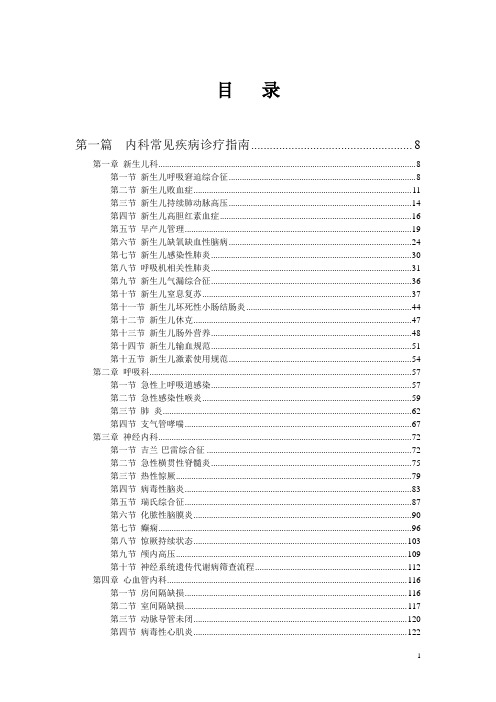
目录第一篇内科常见疾病诊疗指南 (8)第一章新生儿科 (8)第一节新生儿呼吸窘迫综合征 (8)第二节新生儿败血症 (11)第三节新生儿持续肺动脉高压 (14)第四节新生儿高胆红素血症 (16)第五节早产儿管理 (19)第六节新生儿缺氧缺血性脑病 (24)第七节新生儿感染性肺炎 (30)第八节呼吸机相关性肺炎 (31)第九节新生儿气漏综合征 (36)第十节新生儿窒息复苏 (37)第十一节新生儿坏死性小肠结肠炎 (44)第十二节新生儿休克 (47)第十三节新生儿肠外营养 (48)第十四节新生儿输血规范 (51)第十五节新生儿激素使用规范 (54)第二章呼吸科 (57)第一节急性上呼吸道感染 (57)第二节急性感染性喉炎 (59)第三节肺炎 (62)第四节支气管哮喘 (67)第三章神经内科 (72)第一节吉兰-巴雷综合征 (72)第二节急性横贯性脊髓炎 (75)第三节热性惊厥 (79)第四节病毒性脑炎 (83)第五节瑞氏综合征 (87)第六节化脓性脑膜炎 (90)第七节癫痫 (96)第八节惊厥持续状态 (103)第九节颅内高压 (109)第十节神经系统遗传代谢病筛查流程 (112)第四章心血管内科 (116)第一节房间隔缺损 (116)第二节室间隔缺损 (117)第三节动脉导管未闭 (120)第四节病毒性心肌炎 (122)第五节小儿心力衰竭的诊治指南 (124)第五章血液肿瘤科 (130)第一节儿童急性淋巴细胞白血病 (130)第二节儿童急性髓细胞白血病 (136)第三节免疫性血小板减少症 (140)第四节儿童急性特发性血小板减少性紫癜 (142)第五节中性粒细胞减少伴发热的抗生素使用 (145)第六节儿童再生障碍性贫血 (149)第七节儿童血友病 (156)第六章肾脏、免疫科 (163)第一节急性肾小球肾炎 (163)第二节原发性肾病综合征(激素敏感型) (165)第三节过敏性紫癜 (166)第四节先天性肾病综合征 (169)第五节遗传性肾炎 (171)第六节肾小管酸中毒 (172)第七节儿童Bartter综合征 (175)第八节小儿肾功能衰竭 (176)第九节川崎病 (179)第十节渗出性多形红斑 (180)第十一节幼年特发性关节炎 (182)第十二节系统性红斑狼疮 (185)第十三节狼疮性肾炎 (190)第十四节皮肌炎 (194)第十五节先天性无丙种球蛋白血症 (196)第十六节湿疹、血小板减少伴免疫缺陷综合征诊疗指南 (197)第十七节慢性肉芽肿病 (199)第十八节严重联合免疫缺陷病 (200)第七章感染消化科 (202)第一节麻疹 (202)第二节流行性腮腺炎 (205)第三节水痘 (207)第四节流行性乙型脑炎 (208)第五节EB病毒感染 (212)第六节巨细胞病毒感染 (215)第七节手足口病 (218)第八节猩红热 (223)第九节细菌性痢疾 (226)第十节流行性脑脊髓膜炎 (228)第十一节结核病 (231)第十二节梅毒 (236)第十三节肺吸虫病 (239)第十四节慢性胃炎 (242)第十五节消化性溃疡 (245)第十七节发热待查 (254)第十八节慢性腹泻 (264)第十九节肝脾肿大原因待查 (271)第二十节、浆膜腔积液原因待查 (278)第二十一节侵袭性真菌感染 (280)第八章内分泌科 (285)第一节矮小症 (285)第二节儿童糖尿病 (286)第三节先天性肾上腺皮质增生症 (290)第四节肥胖症 (292)第五节中枢性尿崩症 (295)第六节性早熟 (298)第七节糖尿病酮症酸中毒 (300)第八节低血糖症 (303)第九节肾上腺危象 (305)第十节内分泌特殊检查诊疗规范 (306)第十一节糖皮质激素临床使用规范 (312)第九章重症医学科 (317)第一节心肺脑复苏抢救常规 (317)第二节脓毒症(感染性)休克抢救常规 (327)第三节急性呼吸衰竭的抢救常规 (331)第四节心力衰竭的抢救常规 (333)第五节急性中毒抢救常规 (335)第十章康复科 (342)第一节格林巴利综合症的康复指南 (342)第二节脊髓炎的康复指南 (347)第三节弥漫性轴索损伤的康复指南 (358)第四节脑性瘫痪的康复指南 (363)第五节各种脑炎的康复指南 (372)第六节周围神经损伤 (376)第二篇外科常见疾病诊疗指南 (379)第一章肝胆外科 (379)第一节胆道扩张 (379)第二节肝脏损伤 (380)第三节小儿肝脏肿瘤 (381)第四节黄疸 (384)第五节儿童门静脉高压 (390)第二章新生儿胃肠外科 (395)第一节急性肠套叠 (395)第二节腹股沟疝 (396)第三节急性阑尾炎 (397)第四节先天性肠旋转不良 (398)第六节先天性肛门直肠闭锁 (401)第七节先天性幽门肥厚性狭窄 (402)第八节新生儿肛周脓肿 (403)第三章泌尿外科 (405)第一节尿道下裂 (405)第二节肾盂输尿管交界处梗阻所致肾积水 (408)第三节隐睾 (411)第四节阴囊急症 (414)第五节肾母细胞瘤 (417)第六节肾挫裂伤 (420)第七节嗜铬细胞瘤危象 (422)第八节腹膜后神经母细胞瘤 (424)第九节盆腔泌尿生殖器肿瘤 (426)第四章心胸外科 (429)第一节先天性心脏病 (429)第二节漏斗胸 (437)第三节心包炎 (438)第四节脓胸 (439)第五节心胸外科急诊服务流程 (440)第五章骨科 (446)第一节儿童肱骨髁上骨 (446)第二节儿童髋关节暂时性滑膜炎 (448)第三节发育性髋关节脱位 (450)第四节先天性肌性斜颈 (454)第五节先天性马蹄内翻足 (457)第六节发育性髋脱位 (460)第七节内固定取出术 (461)第八节斜颈手术 (461)第九节肱骨髁上骨折 (462)第十节滑膜炎 (463)第十一节儿童肱骨髁上骨折手术前后操作规范 (464)第六章烧伤整形科 (465)第一节烧伤 (465)第二节先天性唇腭裂 (470)第三节多、并指畸形 (474)第四节瘢痕畸形 (477)第五节皮肤病变与体表包块的整形外科诊疗 (481)第六节吸入性损伤诊疗指南 (484)第七节激素注射防治瘢痕的操作规范 (486)第七章神经外科 (488)第一节脑震荡 (488)第二节脑挫裂伤 (488)第三节弥漫性轴索损伤 (490)第五节开放性颅脑损伤 (491)第六节小儿后颅窝肿瘤 (492)第七节小儿脑积水 (493)第八节脊髓栓系综合症 (494)第九节自发性颅内出血 (495)第十节难治性癫痫 (504)第八章肿瘤外科 (509)第一节儿童非霍奇金淋巴瘤 (509)第二节畸胎瘤 (518)第三节软组织感染及淋巴结病变 (520)第四节肿瘤外科常用化疗药及化疗辅助用药 (523)第三篇专科科室常见疾病诊疗指南 (526)第一章口腔科 (526)第一节乳牙龋病 (526)第二节乳牙牙髓病 (527)第三节疱疹性口炎 (530)第四节牙发育异常 (531)第五节混合牙列异常 (539)第二章眼科 (545)第一节白内障 (545)第二节结膜炎 (547)第三节泪道病 (559)第四节内斜视 (562)第五节外斜视 (565)第六节眼睑与睫毛位置异常 (567)第三章皮肤科 (572)第一节特应性皮炎 (572)第二节脓疱疮 (576)第三节荨麻疹 (577)第四节丘疹性荨麻疹 (580)第五节湿疹 (581)第四章耳鼻喉科 (585)第一节变应性鼻炎 (585)第二节先天性耳前瘘管 (587)第三节阻塞性睡眠呼吸暂停低通气综合征 (588)第四节儿童鼻窦炎 (589)第五节中耳炎 (592)第五章麻醉科 (596)第一节低体重新生儿麻醉指南 (596)第二节小儿麻醉气道和呼吸管理指南 (602)第三节临床麻醉监测指南 (615)第四节小儿术前禁食指南 (622)第六节围术期输血指南 (633)第四篇儿科常用操作规范 (642)第一章常用操作规范 (642)第一节腹膜腔穿刺术操作规程 (642)第二节骨髓穿刺术 (644)第三节腰椎穿刺术 (646)第四节胸腔穿刺术 (647)第五节膀胱穿刺术 (648)第六节人工呼吸术 (649)第七节心包穿刺术 (652)第八节心电图操作常规 (654)第九节胸腔闭式引流术 (654)第十节胸腔减压术 (655)第十一节硬膜下穿刺术 (655)第十二节肿瘤穿刺活检标准操作规范 (657)第二章口腔科常用操作规范 (661)第一节根管治疗术操作规范 (661)第二节玻璃离子材料充填术操作规范 (665)第三节乳牙拔除术操作规范 (667)第四节窝洞制备操作规范 (670)第五节乳牙干髓术操作规范 (673)第三章皮肤科常用操作规范 (675)第一节色素激光(MEDLITE C6激光治疗仪)操作常规 (675)第二节NB-UVB(Waldmam UV-100)紫外光疗仪操作规范 (676)第三节点刺试验的操作规范 (677)第四节超脉冲二氧化碳激光治疗仪操作常规 (678)第五节高频手术系统ELLMAN 治疗仪操作规程 (679)第六节冷湿敷的操作规范 (680)第七节连续YAG激光治疗仪操作常规 (680)第八节赛诺秀脉冲染料激光治疗仪操作常规 (681)第九节无针高压注射器的操作规范 (682)第十节氧化锌糊换药的操作规范 (683)第四章麻醉科常用操作规范 (686)第一节气管插管操作技术规范 (686)第二节静脉复合+部位麻醉术中管理技术规范 (687)第三节椎管内麻醉操作技术规范 (688)第四节臂丛神经组织操作技术规范 (690)第五节中心静脉穿刺操作技术规范 (691)第六节输血技术规范 (693)第七节术中控制性低血压操作技术规范 (695)第八节危重病人抢救及基础生命支持技术操作规范 (697)第九节麻醉复苏室日常工作技术规范 (698)第十节应急抢救操作技术规范 (700)第十一节困难气道处理操作技术规范 (700)第十二节日常麻醉工作技术规范 (703)第十三节体外循环室工作规范 (707)第五章输血适应症与输血指南 (713)第一节手术及创伤输血指南 (713)第二节内科输血指南 (718)第一篇内科常见疾病诊疗指南第一章新生儿科第一节新生儿呼吸窘迫综合征【NRDS诊断标准】(一).具有发病的高危因素:母孕期患有糖尿病、胆汁淤积、宫内感染、早产、胎膜早破超过24小时、宫内窘迫、剖宫产、产时窒息等。
【儿科学】儿童糖尿病

临床表现
1型糖尿病患者起病较急骤,多有感染或饮食不当等诱因。 其典型症状为多饮、多尿、多食和体重下降(即“三多一少”)。 但婴儿多饮、多尿不易被发觉,很快即可发生脱水和酮症酸中毒。 儿童因为夜尿增多可发生遗尿。年长儿还可出现消瘦、精神不振、 倦怠乏力等体质显著下降症状。 约40%糖尿病患儿在就诊时即处于酮症酸中毒状态,这类患儿常因 急性感染、过食、诊断延误、突然中断胰岛素治疗等因素诱发。多 表现为起病急,进食减少,恶心,呕吐,腹痛,关节或肌肉疼痛, 皮肤黏膜干燥,呼吸深长,呼气中带有酮味,脉搏细速,血压下降, 体温不升,甚至嗜睡、淡漠、昏迷。常被误诊为肺炎、败血症、急 腹症或脑膜炎等。少数患儿起病缓慢,以精神呆滞、软弱、体重下 降等为主。
儿童糖尿病
讲者: 时间:
概念
糖尿病( diabetes mellitus,DM)是由于胰岛素分泌绝对缺乏或相对不足所造成的糖、 脂肪、蛋白质代谢紊乱症,分为原发性和继发性两类。
原发性糖尿病又可分为:
①I型糖尿病 ②II型糖尿病
③青年成熟期发病型糖尿病
④新生儿糖尿病
概念
①I型糖尿病
由于胰岛β细胞破坏,胰岛素分泌绝对不足所造成,必须使用胰 岛素治疗,故又称胰岛素依赖性糖尿病(insulin dependent diabetes mellitus,IDDM)。
概念
②II型糖尿病
由于胰岛β细胞分泌胰岛素不足或靶细胞对胰岛素不敏感 (胰 岛素抵抗)所致,亦称非胰岛素依赖性糖尿病( noninsulindependent diabetes mellitus, NIDDM)。
概念
③青年成熟期发病型糖尿病
是一种罕见的遗传性β细胞功能缺陷症,属常染色体显性遗传;
概念
儿童糖尿病护理PPT课件

第三部分:家 庭护理建议
第三部分:家庭护理建议
心理护理:介绍家属如何给予儿童 糖尿病患者心理方面的支持和帮助 。 家庭护理:介绍家属在日常生活中 如何关心儿童糖尿病患者,并提供 一些相关实用技巧和建议。
第三部分:家庭护理建议
康复指导:介绍患者如何寻求康复帮助 ,以及康复对于儿童糖尿病患者的重要 性。
结论
结论
知识总结:结合所述知识对儿 童糖尿病护理进行总结,并提 出相应的建议和思考。
免责声明:强调此次PPT内容仅 作为儿童糖尿病护理相关知识 的介绍和普及,并不意味着对 用户的任何行为给予指导或建 议。
谢谢您的观赏聆听
儿童糖尿病护理PPT课件
目录 第一部分:什么是儿童糖尿病 第二部分:儿童糖尿病护理 第三部分:家庭护理建议 结论
第一部分:什 么是儿童糖尿
病
第一部分:什么是儿童糖尿病
简介:介绍儿童糖尿病的基本概念 ,包括病因、发病率等。 症状:详细阐述儿童糖尿病的症状 和表现。
第一部分:什么是儿童糖尿病
防范:介绍预防儿童糖尿病的方法和措 施,如饮食和运动等。
第二部分:儿 童糖尿病护理
第二部分:儿童糖尿病护理
饮食:详细介绍儿童糖尿病患 者的饮食要求和须遵循的饮食 原则。 运动:介绍运动二部分:儿童糖尿病护理
合理用药:介绍儿童糖尿病患者的用药 原则和药物的注意事项。 血糖监测:介绍儿童糖尿病患者如何自 我监测血糖,并阐述血糖监测的目的及 意义。
儿童期糖尿病医学ppt课件

编辑版ppt 12
• 特点:胰岛素抵抗性糖尿病、局部或全身皮下脂肪组织缺失、高甘油三脂血症。还可伴有黑棘 皮症、肝脾肿大、结节性黄瘤、基础代谢率升高、无酮症。• 先天性脂肪萎缩常染色体显性遗传: 染色体1q的LMNA基因亚型1:皮下脂肪局限在四肢,面部和躯干较少受累,腔内脂肪沉积。亚型2:四肢、躯干受累,但会阴部例外。常染色体隐性遗传:更普遍,父母近亲,男女分布均等。婴儿期即有皮下脂肪缺失和肌肉肥大,糖尿病常在青春期或青春期后出现。面部和口腔也受 累,但乳房脂肪、手掌、足底、头皮、会阴起机械支撑作用的脂肪仍存在。9q34的AGPAT2基因、 11q13的BSCL2基因等• 获得性脂肪萎缩:全身性脂肪萎缩散发性,无家族遗传,发病前常有病毒感染史。常在儿童期或青春期开始后不久起病,女: 男=2:1。临床糖尿病常在脂肪萎缩后平均4年出现。局部性脂肪萎缩可能为全身性中的一种程度较轻的变异,有时候局部类型可发展成为全身性类型。 最常见类型为面部和躯干脂肪消失而腰部以下脂肪正常或沉积增多。偶尔可只累及下身或脂肪萎缩呈节段性皮肤瘤样分布常有低补体血症,还可伴发膜增殖性肾小球肾炎。
儿童糖尿病
编辑版ppt 1
概 述• 儿童糖尿病(juvenile diabetes): 15岁或 20岁以前发生的糖尿病。• 病因不一,临床和治疗、预后不同。• 1型糖尿病患者占95%。• 其次为2型糖尿病患者,且患病率逐渐增多。• 其他特殊类型糖尿病。
10岁以前不发病 青少年、成人早 期(平均23岁)
成人早期,平均 诊断年龄35岁
青少年成人早期平均诊断年龄<25 岁
不确定
高血糖严重程 度
进行性加重,持续的高血糖(18 小时)不能刺激其 B细胞
轻度, FBG 6-9 mmol/L,糖负荷 后<3mmol/L,随 年龄恶化较少
儿童糖尿病PPT课件

• 根据患儿习惯采用1/5、2/5、2/5或1/3、1/3、1/3分 配,夜间易出现低血糖者,可按1/6、1/3、1/3、 1/6分配,睡前可进食小餐。血糖波动大的患儿,则 以少食多餐为宜。
起病
临床特点
酮症 C肽 治疗 相关的自身免疫 性疾病
1型糖尿 2型糖尿病 病
急性起病-症状明 缓慢起病-症状不明显 显
体重下降 多尿 烦渴多饮
肥胖 较强的2型糖尿病家族 史 种族性高发病率族群 黑棘皮病 多囊卵巢综合症
常见
通常没有
低/缺乏
正常/升高
胰岛素 有
生活方式口服药或胰 岛素
无
儿童1型糖尿病
㈠1型糖尿病 ㈡2型糖尿病 ㈢儿童期特殊类型糖尿病
儿童期特殊类型糖尿病
1.青少年发病型的成人糖尿病(MODY)
(1)起病一般在25岁前; (2)常连续3代有人发病,症状、体征相似; (3)非Ins依赖,至少起病5年内不需Ins治疗; (4)原发性Ins分泌障碍,而不是IR; (5)无DKA。
2 . 线粒体糖尿病。 3 . A型抗胰岛素糖尿病。 4. 其他类型:胰腺外分泌功能疾病.巨人 症.柯兴综合症等
• 目前常用的2、3次/d短效/速效胰岛素+中效胰岛素 方法,通常有50%~70%个体不能将血糖控制在目 标值范围内,因此ADA推荐采用餐时胰岛素+基础 胰岛素方案。
• ADA批准的第一个基础Ins为甘精胰岛(glargine), 通常在睡前注射,注射后几乎无峰值,维持时间为 20~24h。餐时Ins采用超短效或短效Ins,这种方 法可使FBG进一步降低,且可减少夜间低血糖的发 生。
• 1.遗传易感性 与某些特殊HLA类型有关 • 2.启动自身免疫反应 环境因素如病毒感染可直接损伤胰岛
儿童糖尿病诊疗指南

儿童糖尿病诊疗指南【概述】儿童糖尿病(diabetes mellitus,DM)是由于胰岛素缺乏所造成的糖、脂肪、蛋白质代谢紊乱症。
分为原发性和继发性两类。
原发性糖尿病又可分为① 1型糖尿病:由于胰岛细胞β破坏,胰岛素绝对分泌不足所造成,必须使用胰岛素治疗,故又称胰岛素依赖性糖尿病。
② 2型糖尿病:由于胰岛细胞分泌胰岛素不足或靶细胞对胰岛素不敏感(胰岛素抵抗)所致。
③青少年成熟期发病型:是一种罕见的遗传性β细胞功能缺陷症,属常染色体显性遗传。
继发性糖尿病大多由一些遗传综合征和内分泌疾病所引起。
98%的儿童糖尿病为1型糖尿病,2型糖尿病较少,但随着儿童肥胖症的增多而有增加趋势。
【病史要点】1.多饮、多尿、多食和体重下降(即三多一少)发生的时间和进展程度。
是否伴倦怠乏力、精神不振、反复感染。
是否伴神志改变、恶心、呕吐、腹痛、关节或肌肉疼痛。
2.详细询问有无糖尿病家族史。
3了解有无流行性腮腺炎病史及胰腺炎病史4.既往治疗情况,是否用过胰岛素,有无突然中断胰岛素治疗。
【体检要点】1.消廋程度,生长发育有无落后。
2.有无脱水征、有无呼吸深长,呼吸有无酮味,有无神志改变。
3.体格发育、肝脏大小、有无腹胀、腹压痛。
4.血压、呼吸、心率、心音,四肢末端循环。
【辅助检查】1.尿液检查:尿糖、尿酮体、尿蛋白。
2.血液检查:血糖、血脂、血气分析、糖化血红蛋白、电解质、肝肾功能。
3.葡萄糖耐量试验。
4.胰岛素C肽释放试验【诊断要点及鉴别诊断】典型病例症状为多饮、多尿、多食和体重下降(即三多一少)。
空腹血糖≥7.0mmol/L随机血糖11.1≥ mmol/L,尿糖阳性。
对有多饮、消廋、遗尿症状的患儿;或有糖尿病家族史者;或有不明原因的脱水、酸中毒的患儿都应考虑本病的可能性,避免误诊。
胰岛素、C肽释放试验有确诊意义。
本病应与下列情况相鉴别。
1.婴儿暂时性糖尿病因不明,可能与患儿胰岛β细胞功能发育不够成熟有关。
多在出生后6周内发病,表现为发热、呕吐、体重不增、脱水等症状。
糖尿病教案模板范文幼儿园

活动名称:了解糖尿病,保护小身体适用年龄:4-6岁活动领域:健康、社会活动目标:1. 了解糖尿病的基本知识,知道糖尿病不是传染病,不会传染给他人。
2. 认识到保持健康饮食和规律运动的重要性,初步形成良好的生活习惯。
3. 学会关心和帮助有糖尿病的朋友,培养同理心。
活动准备:1. 教学挂图:糖尿病相关知识图片、健康饮食和运动方式图片。
2. 糖尿病知识卡片。
3. 小组讨论材料:问题卡片、记录纸。
活动过程:一、导入活动(5分钟)1. 教师通过故事或儿歌导入,引起幼儿对糖尿病的兴趣。
2. 提问:“你们知道什么是糖尿病吗?”二、基本知识讲解(10分钟)1. 教师通过图片和简单易懂的语言,向幼儿讲解糖尿病的基本知识。
2. 重点讲解糖尿病不是传染病,不会传染给他人。
3. 讲解健康饮食和规律运动的重要性。
三、小组讨论(15分钟)1. 将幼儿分成小组,每组发放糖尿病知识卡片和问题卡片。
2. 小组成员互相讨论,回答问题,并记录讨论结果。
3. 教师巡视指导,确保每个幼儿都能参与讨论。
四、健康生活方式实践(15分钟)1. 教师带领幼儿进行健康饮食和运动方式的实践。
2. 例如,展示健康的食物图片,让幼儿认识并说出它们;进行简单的运动游戏,如跳绳、拍球等。
五、总结与延伸(5分钟)1. 教师总结本次活动,强调健康饮食和规律运动的重要性。
2. 引导幼儿关心和帮助有糖尿病的朋友,培养同理心。
活动延伸:1. 教师可以设计相关的手工活动,让幼儿制作健康饮食和运动方式的卡片,增强幼儿的记忆。
2. 家园合作,鼓励家长在家中也引导幼儿保持健康的生活习惯。
注意事项:1. 教师在讲解过程中,要使用简单易懂的语言,避免使用专业术语。
2. 活动过程中,教师要关注每个幼儿的参与情况,确保每个幼儿都能得到锻炼和提升。
3. 教师要引导幼儿正确对待糖尿病,消除对糖尿病患者的歧视和偏见。
通过本次教育活动,希望幼儿能够了解糖尿病的基本知识,认识到保持健康饮食和规律运动的重要性,为幼儿的健康成长奠定基础。
儿童1型糖尿病课件

病毒感染、化学物质、药物等环境因 素可能诱发或加重儿童1型糖尿病。
临床表现与诊断标准
临床表现
儿童1型糖尿病的典型表现为多饮、 多尿、多食和体重下降(三多一少) ,部分患儿可能出现疲乏无力、精神 不振等症状。
诊断标准
血糖升高是诊断儿童1型糖尿病的主要 依据,通常表现为空腹血糖 ≥7.0mmol/L或随机血糖≥11.1mmol/L, 同时胰岛素分泌不足。
儿童1型1型糖尿病的预防与控制 • 儿童1型糖尿病的治疗与管理 • 儿童1型糖尿病的并发症与风险 • 儿童1型糖尿病的教育与心理支持
01
儿童1型糖尿病概述
定义与类型
定义
儿童1型糖尿病是一种自身免疫性 疾病,由于胰腺β细胞受损导致胰 岛素分泌不足,进而引起高血糖。
糖。
环境因素
病毒感染、化学物质、饮食等环 境因素可能诱发1型糖尿病,应
尽量避免。
预防措施
定期监测血糖、保持健康饮食、 加强锻炼、控制体重等。
紧急情况处理与就医建议
紧急情况处理
如出现食欲不振、恶心呕吐、呼吸深 快、腹痛等症状,应立即就医。
就医建议
一旦确诊为1型糖尿病,应定期就诊, 接受专业医生的指导和治疗。
定期监测
定期监测血糖、尿糖等指 标,及时调整治疗方案。
心理支持
关注孩子的心理健康,提 供必要的心理支持和辅导。
饮食与运动建议
均衡饮食
保证营养均衡,摄入足够的蛋白 质、脂肪、碳水化合物、维生素
和矿物质。
控制糖分摄入
减少高糖食品和饮料的摄入,避免 血糖剧烈波动。
适量运动
鼓励孩子参加适量的运动,如散步、 游泳、骑车等,有助于控制血糖水 平。
除了传统的教育资源外,还可以利用现代科技手段, 如在线课程、APP等,方便家长和孩子随时随地学习 相关知识和管理技能。
《儿童时期糖尿病》PPT课件
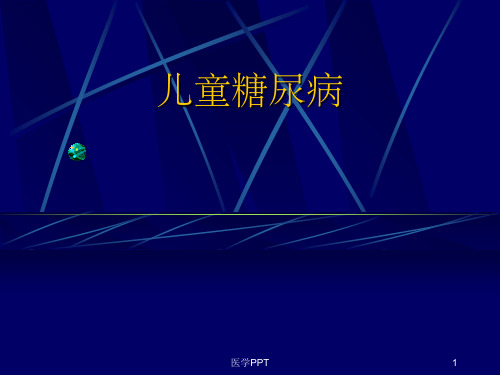
4.永久糖尿病期:经强化治疗,胰岛素用量固定, 病情稳定。
医学PPT
22
胰岛素制剂的进展
一、来源: 1. 动物来源:猪、牛胰岛素 2. 半合成胰岛素: 3. 基因重组人胰岛素:结构与人自然分泌
的完全相同. 二、纯度:单组份、单峰。
医学PPT
23
胰岛素应用方法:
保护性基因: HLA-DQA1*0102; HLA-DQB1*0602
同卵双胎先后发病的一致性约为36.5%-46,5%. 阳性家族史.
医学PPT
5
2. 环境因素: 较为复杂. 病毒感染,如:克萨奇病毒, 巨细胞病毒, 脑心肌病毒等 年龄 出生体重 不同地区发病率相差很大.
医学PPT
6
3. 免疫因素: 体液免疫:自身抗体的出现,如谷氨酸
青春期 1.0~1.5u/kg/d. 2.种类:
种类
RI NPH PZI
开始 0.5h 2h 4~8h
作用时间
最强 2~4h 4~12h 14~20h
医学PPT
最长 6~8h 24h 24~36h
14
3.胰岛素调节:每3~4天调节一次,每次 2~4u。
4. 联合应用胰岛素:
1.RI+NPH 1:2 1:3 2.RI+PZI 2:1 3:1 3.RI/NPH: 30%RI:70%NPH 5.与饮食相结合的原则:
脱羧酶(GAD),胰岛细胞抗体等,可能导致 免疫细胞间的复杂过成,产生一些有攻击 胰岛细胞作用的细胞因子 ,如IL-1;TNFv;NO导致胰岛B细胞的死亡.
医学PPT
7
临床表现
1.发病较急,大约20-30%以酮症酸中 毒为首发症状。
儿童糖尿病.PPT课件

2019/10/23
3
糖尿病诊断标准(ADA2009)
空腹血浆葡萄糖≥7.0mmol/L 糖尿病症状+任意时间血浆葡萄糖
≥11.1mmol/L OGTT,2h 血浆葡萄糖≥11.1mmol/L
2019/10/23
4
诊断标准
空腹血糖受损(IFG): 空腹血糖5.6~6.9mmol/L
2019/10/23
22
2019/10/23
23
胰岛素泵
模仿胰腺基础胰岛素的产生,为患者提 供一个全天候的持续胰岛素输注。进餐 时给予餐前大剂量,模拟了进食后胰岛 素分泌的正常生理高峰。
2019/10/23
24
口服药物治疗
二甲双胍
目前唯一推荐用于儿童青少年2型糖尿病 治疗的口服药物。
机制:作用于肝脏、肌肉和脂肪组织的 胰岛素受体,减少肝糖异生,增加肌肉 和脂肪组织对葡萄糖的利用。
2019/10/23
33
行为问题
发生行为问题的原因及影响因素
患儿生活方式的巨大改变,尤其是1型糖尿病 必须终生使用胰岛素,严格的饮食管理及应对 可能频繁出现的低血糖
孩子患上糖尿病,家长的应激反应,及长久的 治疗给家长带来的心理负担和经济负担,对孩 子升学、就业、婚姻等方面的思想负担,导致 儿童家长心理障碍
39
低血糖
临床表现 心慌、饥饿感、出汗、手抖、面色苍白 头晕、嗜睡、视物模糊、抽搐、昏迷 实验室检查 血糖<3.9mmol/L(ADA2005)
2019/10/23
40
低血糖的治疗
轻-中度低血糖:自觉不适感,能自己或请 求他人帮忙
口服10~20g可迅速吸收的碳水化合物 (2茶匙葡萄糖、100ml可乐、2-3块糖)
《儿科儿童糖尿病》PPT课件
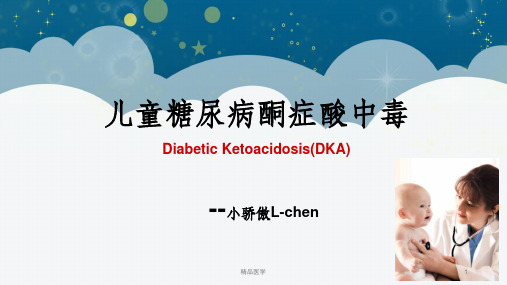
精品医学
18
儿童糖尿病酮症酸中毒
其他治疗 纠酸
只有当动脉血气p11<6. 9休克持续不好转,心 脏收缩力下降时可以考虑使用
5 % NaHC03. 1-2ml/kg稀释后在Ih以上时间内缓 慢输入,必要时可以重复 补钾:见尿补钾
精品医学
19
儿童糖尿病酮症酸中毒
脑水肿 高危因紊 补液量>4L(m2.24h)
精品医学
10
儿童糖尿病酮症酸中毒
液体疗法一48H均衡补液法
·总液体张力的1/2张.补液总量=累计损失+生理需要,总量不
超过每日维持量1.5-2倍,无需除去快速补液所用液体量.匀速
进入。
快速补液:中重度脱水尤其休克.NS10-20ml/kg, 30`60min输
入.必共时可重复.第一小时不超过30ml/kg.继之予0.45%的生
0.9氯化钠+5%葡萄糖+胰岛素3-4g糖/1U胰岛素+氯化钾
其它:1.碳酸氢钠(PH>7.2时停用)2.甘露醇
3
3. 3%氯化钠5-10ml/kg,30分入?4.口服氯化钾
5抗生素及其它药物。
48-72h逐步纠正酮症酸
中毒的代谢紊乱,
逐步改皮下
胰岛素输注持续至酮症酸中毒纠正(连续2次尿酮阴性、动脉血 PH》7.3、血糖《12)。尿酮转阴后,如患儿清醒可进食,皮下注射
胰岛素应用 胰岛素一般在补液后1-2h开始应用 小剂量胰岛素最初量为0.1u/(kg*h)(静 脉维持) 血糖下降速度一般为每小时2-5mmol/L 当临床状况稳定,酸中毒纠正.改皮下胰岛 素
精品医学
13
儿童糖尿病酮症酸中毒
胰岛素治疗
·只有当通过急诊复苏休克完全恢复,盐/钾补
儿童常见疾病治疗——第十三章内分泌系统(共27张PPT)
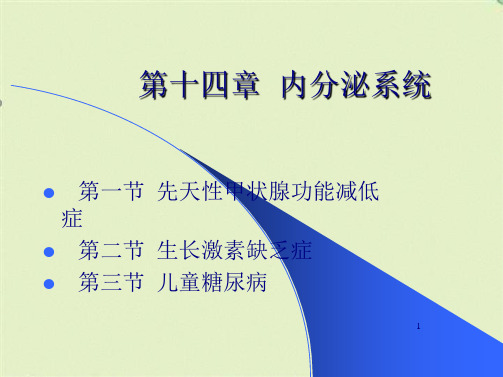
心理社会状况
评估家长认识程度、服药要求、经 济状况、家长会出现焦虑、患儿自卑心 理。
13
治疗原则
甲状腺素片终生替代疗法。疗效取 决于治疗开始时间。出生1~2个月开始 治疗者,不留神经系统损害;3个月治疗 74%智商在90以上;4~6个月治疗33%智 商在90以上。
14
三.护理诊断
1.体温过低 与新陈代谢降低、活动量减 少有关
根据病因可分为两类: 1.散发性:先天性甲状腺发育不良、异位或甲状腺激 素合成途径中酶缺陷。 2.地方性:地方饮食缺碘,胎儿时期甲状腺功能低下。
5
甲状腺激素的生理和病理生理
1.甲状腺激素的合成:血循环中的无机碘 被摄取到甲状腺滤泡上皮细胞内,合成 甲状腺素(T4)和三碘甲腺原氨酸(T3)。
2.合成和释放的调节:受下丘脑分泌的促 甲状腺激素释放激素(TRH)和垂体分 泌的卒甲状腺(TSH)的控制。
2.促进智力发育: 3.用药护理: 4.健康教育:坚持终身服药。
16
第二节 生长激素缺乏症
growth homone deficiency,GHD又 称垂体性侏儒症,是由于垂体前叶分泌 的生长激素不足引起的生长发育障碍。
部分患儿伴有性腺、甲状腺和肾上 腺皮质功能低下。
17
一.病因和发病机制
1.散发性: (1)新生儿期:最早出现生理性黄疸延长。生理功
能低下。 (2)典型表现:特殊面容和体态、神经发育延迟、
生理功能低下。 2.地方性:黏液性水肿、神经型、混合型
11
实验室及其他检查
1.骨龄测定:落后 2.血清T3、T4、TSH测定:T4低、TSH增 高 3.甲状腺131I吸收率测定:散发性的131I降 低 4.其他:放射性核素、TRH刺激实验
《儿科儿童糖尿病》课件
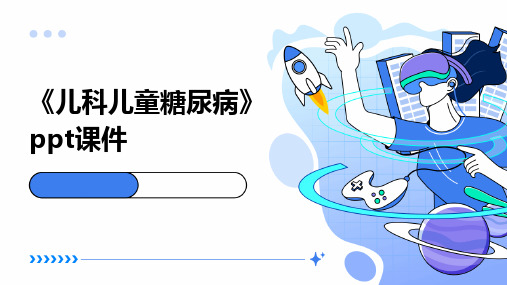
02
儿童糖尿病的治疗
饮食治疗
01
02
03
饮食原则
控制总热量摄入,保证营 养均衡,适当增加膳食纤 维摄入,避免高糖、高脂 肪食物。
每日热量计算
根据孩子的年龄、身高、 体重和活动量计算每日所 需热量,制定个性化的饮 食计划。
定时定量
建立规律的进食时间和量 ,避免过度饥饿或暴饮暴 食。
运动治疗
运动原则
《儿科儿童糖尿病》 ppt课件
目录
CONTENTS
• 儿童糖尿病概述 • 儿童糖尿病的治疗 • 儿童糖尿病的预防与护理 • 儿童糖尿病的并发症与预后
01
儿童糖尿病概述
定义与分类
总结词
儿童糖尿病是指发生在18岁以下儿童的糖尿病类型,主要分为1型糖尿病和2型糖尿病。
详细描述
儿童糖尿病是一种慢性代谢性疾病,主要由于胰岛素分泌不足或胰岛素作用障碍导致高血糖。1型糖尿病多发生 在儿童期,主要由于自身免疫破坏胰岛B细胞,导致胰岛素分泌不足。2型糖尿病则多见于青春期肥胖的儿童,与 遗传和环境因素有关。
临床表现与诊断
总结词
儿童糖尿病的临床表现多样,诊断需结 合症状、实验室检查和排除其他疾病。
VS
详细描述
儿童糖尿病的典型表现为多饮、多尿、多 食和体重下降,即“三多一少”。部分患 儿可能出现疲乏无力、精神萎靡等症状。 诊断时需进行血糖、尿糖、糖化血红蛋白 等实验室检查,并结合临床表现排除其他 疾病。对于1型糖尿病,还需检查胰岛功 能和自身抗体等指标。
日常护理
监测血糖
家长应定期监测孩子的血糖水平 ,了解血糖控制情况,及时调整
治疗方案。
规律用药
遵循医生的指导,按时按量给孩 子服药,避免漏服或过量使用。
儿童糖尿病考试题及答案

儿童糖尿病考试题及答案一、选择题1. 儿童糖尿病最常见的类型是?A. 1型糖尿病B. 2型糖尿病C. 妊娠糖尿病D. 妊娠期糖尿病答案:A2. 以下哪项不是儿童糖尿病的典型症状?A. 频繁尿尿B. 持续口渴C. 体重增加D. 疲劳无力答案:C3. 儿童糖尿病的诊断标准是什么?A. 空腹血糖≥7.0mmol/LB. 随机血糖≥11.1mmol/LC. 糖化血红蛋白≥6.5%D. 所有以上答案:D4. 儿童糖尿病的血糖控制目标是什么?A. 空腹血糖<7.0mmol/LB. 糖化血红蛋白<7.5%C. 餐后2小时血糖<10.0mmol/LD. 所有以上答案:D5. 以下哪项不是儿童糖尿病的并发症?A. 视网膜病变B. 肾病变C. 神经病变D. 骨折答案:D二、判断题1. 儿童糖尿病只能通过注射胰岛素来控制。
()答案:错误。
儿童糖尿病可以通过饮食控制、运动、口服降糖药和注射胰岛素等多种方式来控制。
2. 儿童糖尿病不需要定期监测血糖。
()答案:错误。
儿童糖尿病患者需要定期监测血糖,以评估血糖控制情况并及时调整治疗方案。
3. 儿童糖尿病患者不能参加体育活动。
()答案:错误。
适当的体育活动有助于儿童糖尿病患者的血糖控制,但应在医生指导下进行。
4. 儿童糖尿病患者不需要特别的饮食控制。
()答案:错误。
儿童糖尿病患者需要根据营养师的建议进行特别的饮食控制,以帮助血糖控制。
5. 儿童糖尿病患者的血糖控制目标与成人相同。
()答案:错误。
儿童糖尿病患者的血糖控制目标可能与成人略有不同,需要根据年龄、病情等因素综合考虑。
三、简答题1. 描述儿童糖尿病的预防措施。
答案:儿童糖尿病的预防措施包括:健康饮食,避免高糖、高脂肪食物;定期体育活动,增强身体素质;定期体检,早发现、早治疗;教育儿童和家长糖尿病知识,提高自我管理能力。
2. 阐述儿童糖尿病患者的血糖监测方法。
答案:儿童糖尿病患者的血糖监测方法主要包括:使用血糖仪进行指尖血糖测试;定期进行糖化血红蛋白检测;在医生指导下,可能还需要进行口服葡萄糖耐量试验等。
幼儿园糖尿病预防主题教案 幼儿园健康教育

幼儿园糖尿病预防主题教案一、背景介绍1.1 糖尿病的发病情况糖尿病是一种常见的慢性代谢性疾病,全球范围内病情逐年增加。
据统计,中国糖尿病人口数量已经超过1亿,居全球之首。
而随着社会经济的发展,糖尿病已逐渐成为中国人口健康的一大隐患。
1.2 幼儿园健康教育的重要性幼儿园阶段是儿童生长发育的重要阶段,也是健康教育的关键时期。
在这个阶段,适当的健康教育可以帮助幼儿树立正确的健康观念,养成良好的生活习惯,预防多种慢性疾病,包括糖尿病。
二、教学目标2.1 知识目标1)了解糖尿病的发病原因和相关知识;2)掌握预防糖尿病的方法;3)学会识别食物中的糖分;4)掌握正确的饮食习惯和运动方法。
2.2 能力目标1)树立正确的健康观念;2)养成良好的生活习惯;3)掌握自我保护的能力;4)学会关注自己和家人的健康。
2.3 情感目标1)培养对健康的重视和珍惜;2)培养良好的饮食和运动习惯;3)培养团结互助的意识;4)增强自信和自律的能力。
三、教学内容3.1 什么是糖尿病糖尿病是一种慢性代谢性疾病,其特点是血糖水平持续升高。
糖尿病分为1型和2型,1型多发生于儿童和青少年,而2型多发生于成年人,但随着生活方式的改变,2型糖尿病在青少年群体中也逐渐增多。
3.2 糖尿病的预防方法1)饮食方面:少食甜食、零食,多摄入蔬菜水果,控制碳水化合物的摄入量;2)运动:加强体育锻炼,增强身体的代谢能力;3)控制体重:保持正常体重,预防肥胖;4)生活习惯:良好的作息习惯,避免过度劳累和情绪焦虑;5)定期体检:寻医问药,定期检查身体健康状况。
3.3 如何识别食物中的糖分幼儿园教师可以引导幼儿通过观察食材包装上的营养成分表,了解食物中的糖分含量。
可以进行一些小游戏,让幼儿通过颜色、口感来分辨甜食和非甜食。
3.4 正确的饮食习惯和运动方法教师可以向幼儿介绍均衡饮食的概念,教育他们如何合理搭配膳食,培养良好的饮食习惯;也可以进行一些简单的运动游戏,让幼儿在娱乐中体验运动的乐趣。
- 1、下载文档前请自行甄别文档内容的完整性,平台不提供额外的编辑、内容补充、找答案等附加服务。
- 2、"仅部分预览"的文档,不可在线预览部分如存在完整性等问题,可反馈申请退款(可完整预览的文档不适用该条件!)。
- 3、如文档侵犯您的权益,请联系客服反馈,我们会尽快为您处理(人工客服工作时间:9:00-18:30)。
第二节儿童糖尿病一、概述Diabetes mellitus (DM) is a chronic metabolic disorder caused by an absolute or relative deficiency of insulin, an anabolic hormone. When DM strikes during childhood, it is routinely assumed to be type 1, or insulin-dependent diabetes mellitus (IDDM). Most children with diabetes have IDDM and a lifetime dependence on exogenous insulin. However, in the last 2 decades, type 2 diabetes (non–insulin-dependent diabetes mellitus, NIDDM) already appears to be a sizable and growing problem among children. It is hard to detect NIDDM in children because 1) it can go undiagnosed for a long time; 2) children may have no symptoms or mild symptoms; and 3) blood tests are needed for diagnosis. DM has a tendency to progression of an array of complications such as microvascular disease, macrovascular disease and nonalcoholic fatty liver disease. Therefore, better physician awareness and monitoring of the disease’s magnitude will be necessary.(一)定义儿童时期的糖尿病是指在15岁以前发生的糖尿病。
以前曾称为儿童糖尿病,但由于儿童时期的糖尿病的病因、临床表现、治疗和预防的不同,儿童糖尿病的名称早已舍弃不用。
通常分为三类:1. 1型糖尿病(type1 diabetes mellitus)主要是在遗传因素作用下,由于环境因素激发的体内自身免疫反应,使胰岛β细胞损伤并遭到破坏,导致胰岛素绝对不足,是胰岛素依赖型糖尿病(insulin-dependentes mellitus, IDDM)。
2. 2型糖尿病(type2 diabetes mellitus)是一类胰岛β细胞分泌胰岛素相对不足或/和靶细胞对胰岛素不敏感,即胰岛素拮抗所致的糖尿病,是非胰岛素依赖型糖尿病。
3. 其他类型β细胞功能的遗传缺陷、胰岛素作用的遗传缺陷、内分泌疾病引起的糖尿病、药物或化学物诱导的糖尿病、感染等。
(二)流行病学儿童时期的糖尿病绝大多数是1型糖尿病中的免疫介导型,但今年儿童的2型糖尿病有逐年增加的趋势。
我国内地22个地区平均发病率为0.56/105,约占糖尿病总发病例数的5%。
儿童时期的糖尿病好发年龄多见于10~14岁,婴幼儿少见。
秋、冬季节高发。
(三)临床表现1型糖尿病儿童起病较急,多数病人常因感染、饮食不当或情绪激惹的诱发起病。
表现为多尿、多饮、易饿多食和体重减轻,俗称“三多一少”。
但多数儿童多饮多尿不易被发现而很快发展为脱水及酮症酸中毒。
糖尿病儿童可以突发恶心、呕吐、厌食或腹痛、腿疼等症状,应考虑酮症酸中毒的可能,应尽早诊断。
体格检查糖尿病时除消瘦外一般无阳性体征。
学龄儿童科发生夜间遗尿,部分儿童食欲正常或减低,体重减轻很快消瘦、乏力及精神萎靡。
二、营养代谢特点DM is caused by the deficiency of insulin, which is produced by the β cells of the islets of Langerhans located in the pancreas, and the absence, destruction, or other loss of these cells results in IDDM. Whereas NIDDM is a heterogeneous disorder independently associated with both impaired β-cell function and insulin resistance.Hyperglycemia results when insulin deficiency leads to uninhibited gluconeogenesis and prevents the use and storage of circulating glucose. The kidneys cannot reabsorb the excess glucose load, causing glycosuria, osmotic diuresis, thirst, and dehydration. Increased fat and protein breakdown leads to ketone production and weight loss. Without insulin, a child with IDDM wastes away and eventually dies from diabetic ketoacidosis (DKA).主要是胰岛和胰岛β细胞数量明显减少,胰岛呈纤维化并萎缩。
胰岛素绝对缺乏,进餐后无胰岛素分泌高峰,餐后血糖升高,血糖水平超过肾阈值从尿中排出而出现多尿和多饮。
脂肪动员分解代谢增加,酮体产生增多,出现酮血症、酸中毒和脱水;体内能量丢失导致体重下降。
糖尿病时反调节激素(如胰高血糖素、肾上腺素、糖皮质激素及生长激素等)增多,加重了代谢紊乱,出现高血糖、搞血脂和高酮血症,同时伴脱水,引起血浆渗透压增高,导致意识障碍甚至昏迷。
胰岛素缺乏引起不可控制的糖异生并阻止循环中糖的利用和储存,此时会导致高血糖的出现。
肾脏不能重吸收过量的糖负荷,从而引起糖尿、渗透性利尿、口渴和脱水。
脂肪和蛋白分解增加可导致酮的生成以及体重减轻。
在没有胰岛素的情况下,IDDM患儿迅速消瘦并最终死于糖尿病酮症酸中毒(DKA)。
三、营养治疗原则Dietary management is essential for diabetes care. The aim of dietary management is to balance the child’s food intake with insulin dose and activity and to keep blood glucose concentrations under close control, avoiding extremes of hyperglycemia and hypoglycemia. A healthy, balanced diet, high in carbohydrates and fiber and low in fat is recommended. The following are universal recommendations: Carbohydrates should provide 50-60% of daily energy intake, fat less than 30% and protein 10-20%.The ability to estimate the carbohydrate content of food is particularly useful for those children who give fast-acting insulin at meal times either by injection or insulin pump, as it allows for a more precise matching of food and insulin.1) Adequate intake of complex carbohydrates (eg, cereals) is important before bedtime to avoid nocturnal hypoglycemia, especially for children having twice-daily injections of mixed insulin.2) The dietitian should develop a diet plan for each child to suit individual needs and circumstances. Regularly review and adjust the plan to accommodate the patient’s growth and lifestyle changes.3) Low-carbohydrate diets as a management option for diabetes control have regained popularity in recent years. Logic dictates that the lower the carbohydrate intake, the less insulin is required. No trials of low-carbohydrate diets in children with IDDM have been reported, and such diets cannot be recommended at the present.糖尿病的饮食治疗是综合治疗不可缺少的一部分,儿童1型糖尿病的饮食治疗有其特殊性,因儿童是在生长发育时期,其饮食的原则应是计划饮食,一要达到控制血糖、血脂和体重的目的,二要保证儿童正常的生长发育的需要,因此不宜过分限制,饮食应能满足患儿的基本需要。
(一)能量的供给总能量应保证儿童的生长和发育的需要,同时维持体重在正常范围。
一般用以下公式计算每日的总热量。
